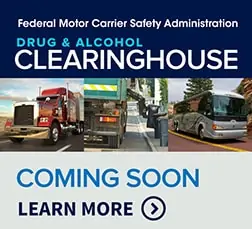To ensure you are prepared on January 6, 2020, when the Federal Motor Carrier Safety Administration (FMCSA) Drug and Alcohol Clearinghouse (Clearinghouse) becomes operational, we want to remind you about an upcoming change related to recording information on the Federal Drug Testing Custody and Control Form (CCF) and Alcohol Testing Form (ATF).
What Changed?
The current versions of the CCF and ATF specifically permit the use of either the driver’s social security number (SSN) or employee identification number (EIN) when completing the CCF or ATF. However, effective January 6, 2020, FMCSA is requiring that the commercial driver’s license number (CDL) must be used instead of the SSN or EIN when FMCSA-covered drivers’ positive drug or alcohol test results are reported to the Clearinghouse.
Therefore, Employers, Consortia/Third Party Administrators (C/TPAs), Collection Sites, Laboratories, and Medical Review Officers (MROs) may want to ensure that their respective data systems can accommodate a donor identification number of up to 25 alphanumeric characters.
What does this mean for Employers, C/TPAs, Collectors and Alcohol Technicians?
In accordance with 49 CFR 382.123(b), the person completing the CCF or the ATF must annotate the driver’s CDL number and State of Issuance in Step 1, Section C of the CCF or Step 1B of the ATF for each FMCSA-regulated test.
If the employer or C/TPA does not provide the CDL and the State of Issuance, then the collector or alcohol technician should ask the driver for this information at the collection site.
Even if the CDL number and State of Issuance is not listed on the CCF, the collector must send the controlled substance test specimen to the laboratory for testing.
What does this mean for Laboratories?
Laboratories who receive a CCF that indicates this is a FMCSA-regulated urine specimen but does not have the driver’s CDL number listed in Step 1 C should process the urine specimen without delay, and send the results to the MRO.
What does this mean for the MRO?
When the MRO receives a laboratory-confirmed positive drug test result for a FMCSA-regulated employee, and the CCF is without the driver’s CDL number and State of Issuance listed, the MRO should contact the driver, driver’s employer or designated employer representative to obtain it. The MRO will report the verified positive test result in the Clearinghouse.
For additional information, please visit https://clearinghouse.fmcsa.dot.gov or send an email to clearinghouse@dot.gov.


